Natural Building around the World: |
 |
 |
|
|
|
|
 |
|
|
|
|
| |
|
Naturally built homes use local, minimally processed, abundant
and/or renewable natural materials. They are designed to suit
their climate and geography, providing a modest shelter that can
last for many centuries. Ideally they, and the way they are
lived in, are in balance and harmony with the environment. The resources used
to build them
are either so abundant that the impact of their use is not
significant or they are easily replenished within the lifetime of
the building.
This collection shows naturally built homes and public
buildings from different climates using a selection of natural
materials and building techniques.
|
|
|
|
|
| |
|
|
|
|
|
|
In many parts of the world the traditional
knowledge and skills used to build natural homes has been, or is
being, lost as people become more dependent on a building industry
that generally uses processed non-local materials. Natural homes
are often built with the knowledge and experience of a supportive
community. Here are nine such examples from around the world. |
|
|
|
|
|
|
|
|
| |
|
|
|
NM, USA |
|
AdobeThis is
Carole Crews
adobe home, although it uses other
natural building techniques too. Adobe is a mixture of clay, sand and
straw formed into blocks which are left to dry in the sun before
being used to build with. Carole tells her story about building
her home in the video below. She has written a book,
Clay Culture,
which takes the reader through the traditional building methods of
New Mexico to the restoration of earthen homes with recipes for
mixing clays.
More
adobe natural buildings... |
|
 |
|
|
|
|
|
|
|
|
| |
|
|
|
Wales |
|
CordwoodThis is the cordwood roundhouse at
Denmark
Farm in Wales. The roundhouse was built in 2008 by
Tony Wrench
leading a collection of over 60 volunteers. You can watch all the
stages in the construction of the roundhouse in the video below.
Tony's cordwood roundhouses epitomise sustainable living. He has
written the book
Building a Low Impact Roundhouse sharing his knowledge and
experience.
More
cordwood buildings...
|
|
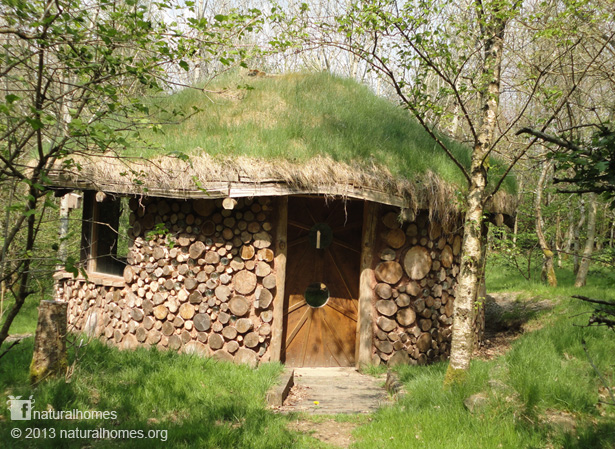 |
|
|
|
|
|
|
|
|
| |
|
|
|
England |
|
RoundwoodThis is
Ben Law's home in Prickly Nut Wood near Lodsworth,
West Sussex, UK. The house is a roundwood sweet chestnut cruck
frame with barley straw bale and wattle & daub walls and a roof of
handmade Cedar shingles. Ben is recreating the human scale
approach to woodland management and sustainable living by
combining sensitive woodland management with permaculture
principles and natural building. He is an inspirational example of
living in symbiosis with the natural environment around him. At
the time few people were using roundwood so Ben developed
construction methods which he later documented in his most recent
book
Roundwood Timber Framing. More about
roundwood building... |
|
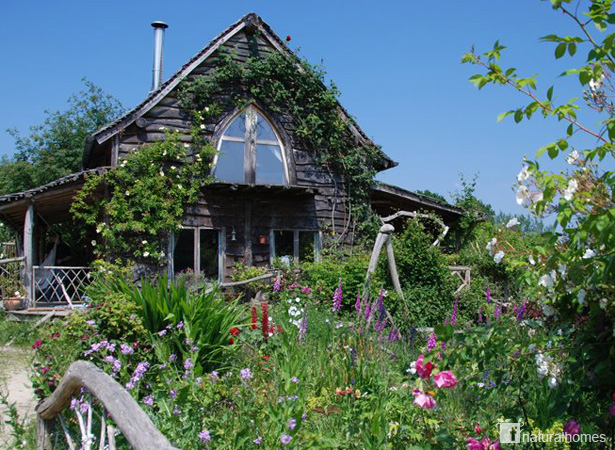 |
|
|
|
|
|
|
|
|
| |
|
|
|
Bali |
|
BambooThese
sea urchin shaped pods are the library and reception at
Bambu Indah,
John Hardy's hotel resort in Bali, Indonesia. The high silica content in bamboo means it cannot be easily
digested by termites. Additional soaking in
borax salt
makes bamboo a reliable building material.
|
|
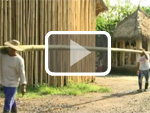
|
|
| |
John Hardy talks about bamboo |
|
More about
bamboo... |
|
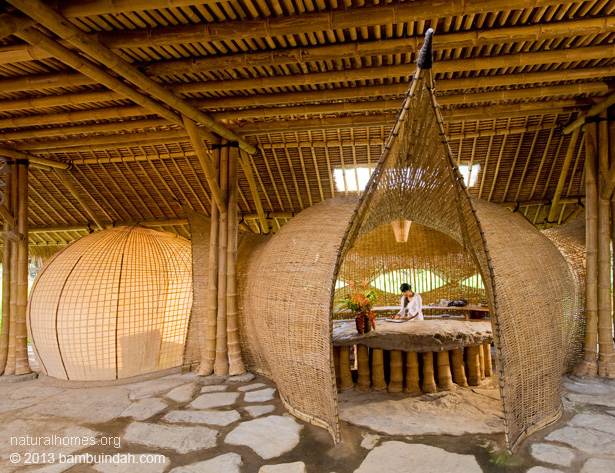 |
|
|
|
|
|
|
|
|
| |
|
|
|
Bhutan |
|
Rammed EarthA typical Bhutanese house (right) is a three storey
rammed earth structure with space for livestock on the ground floor; a grain
store on the middle floor and living quarters on the top floor.
Another storage space is normally kept between the top floor and
the roof for drying meat and vegetables. The windows and
doors of the house are painted with motifs of flowers and animals
as decorations. This is one of the patterns, Ornament,
No.249, recommended by
Alexander. It makes a connection between the elements of the
building and the life around them. More
rammed earth buildings... |
|
 |
|
|
|
|
|
|
|
|
| |
|
|
|
Romania |
|
CobThis is one of the cob homes built by architect and natural builder
Ileana Mavrodin of Casa Verde in Banat, Romania.
Cob is a mixture of sand, clay and straw like adobe but not formed
into bricks. Here's a recent interview with Ileana (in Romanian)
where you can see her beautiful cob home.
|
|
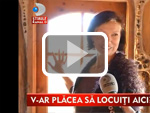
|
|
| |
Ileana talks about her cob home |
|
More about
natural building with cob...
|
|
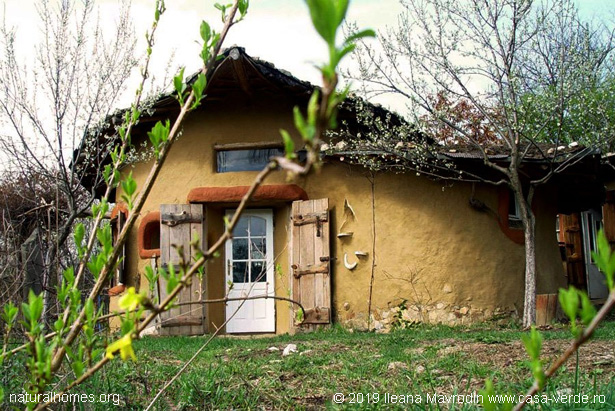 |
|
|
|
|
|
|
|
|
| |
|
|
|
Norway |
|
Turf
This extremely well connected to the earth home is
one of the Sami peopleís Goahti (a turf home, called a Gamme in
Norwegian) used as a summer residence (Siida) at
Gamtofta near Sorreisa, Norway. You can stay in these Sami
homes, sleeping on reindeer skin beds warmed by an open stone
circle fire, while you attend a workshop in Sami crafts (duodji).
The Goahti is built with two arches of timbers
pegged with wooden pins that create a space when more timbers are
laid on the timber arches. The timbers are then protected with
birch bark held in place by thick, warm layers of turf. Here are
the stages in the
construction of the Goahti.
More about
turf homes... |
|
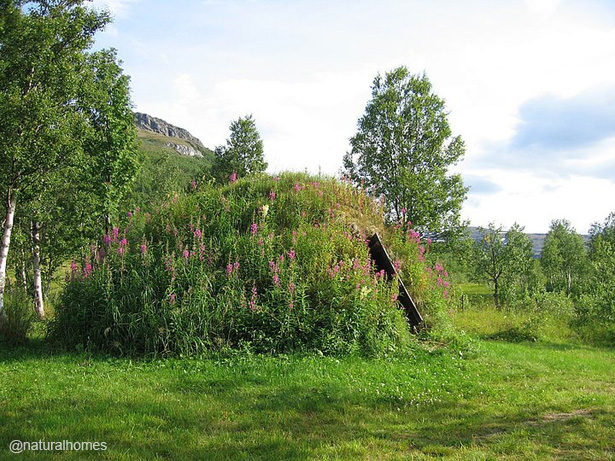 |
|
|
|
|
|
|
|
|
| |
|
|
|
Poland |
|
Straw Bale
This straw bale house was built in 2002 by Paulina
of
Earth Hands and Houses. It sits in beautiful countryside near
Lake Hancza in northeast Poland. To build a home like this today
in Poland would cost about £10,000 ($15,000) in materials but at
the time it was £5,000. Here are pictures of the
straw bale house being built with details of its design.
You will find straw bale homes all over the world.
It is a suitable design for hot and cold and wet and dry climates.
Take a look at some on the
Natural Homes Map. Some more
straw bale homes... |
|
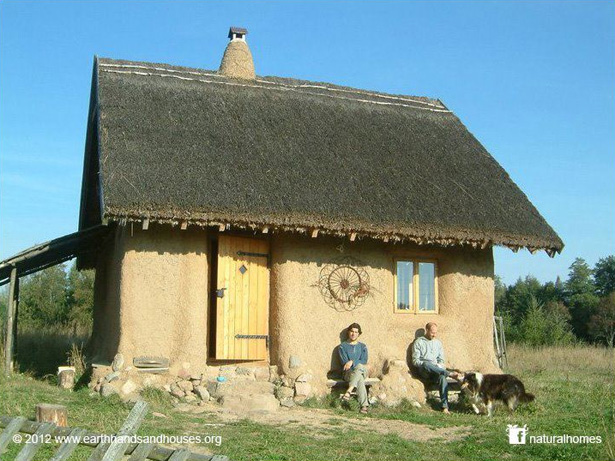 |
|
|
|
|
|
|
|
|
| |
|
|
|
Canada |
|
Dry StoneThis is a traditional
(almost) Scottish dry stone home called a
blackhouse
however this one is in Canada. Here are some
blackhouses
in Scotland. The house was built using
126 tons of stone at Eric Landmanís farm near Grand Valley, ON.
Notice steps are built into the wall leading up to the chimney
and the
green roof. Stone is infinitely reusable and long lasting,
Many stone homes in Europe were built from the homes and
fortifications of earlier settlements. There are many such
examples among the
stone villages of Britain. A collection of
stone buildings... |
|
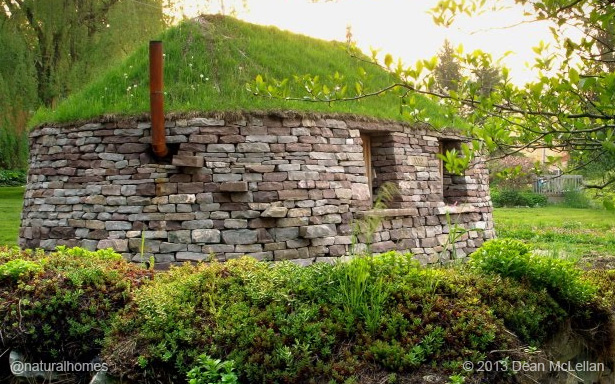 |
|